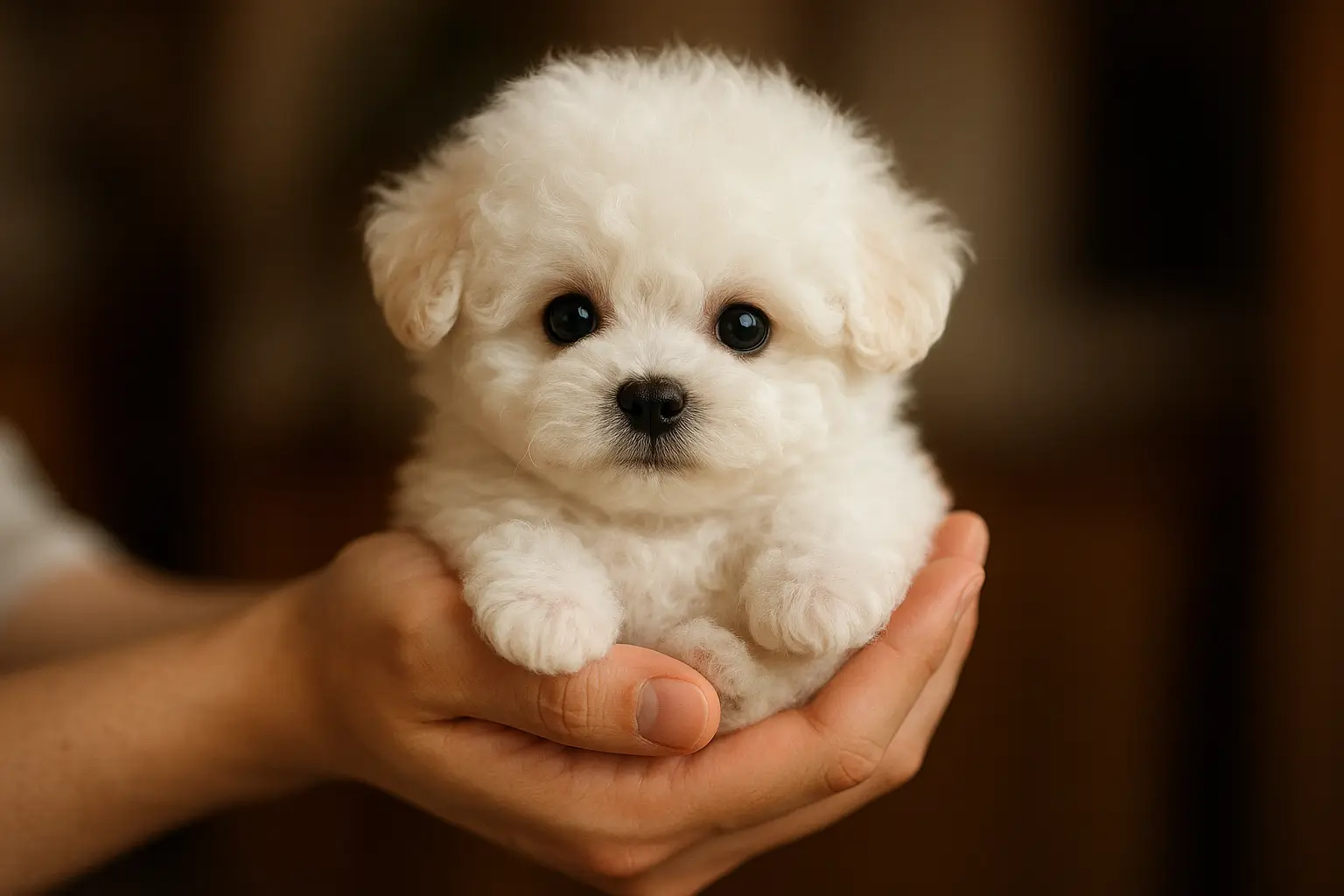Let’s talk about the teacup bull terrier, sometimes called the teacup mini bull terrier. If you’ve ever seen a standard Bull Terrier, you know they’re famous for that distinctive egg-shaped head, muscular build, and clownish personality. Now imagine all of that charisma, but in a smaller, more manageable package. That’s exactly what breeders aim for with the teacup version.
Unlike the recognized Miniature Bull Terrier (acknowledged by the American Kennel Club), the “teacup” label isn’t officially recognized. Instead, it’s a marketing term used for extra-small minis, often bred selectively from the smallest parents. This makes them rare, expensive, and sometimes prone to health concerns.
Despite their compact size, teacup Bull Terriers keep the same big-dog personality. They’re energetic, playful, and a little mischievous, the kind of pup that will make you laugh one second and test your patience the next. With early training and lots of love, they can grow into loyal, entertaining companions perfect for families who love a dog with spunk.
Origin & History of the Teacup Bull Terrier
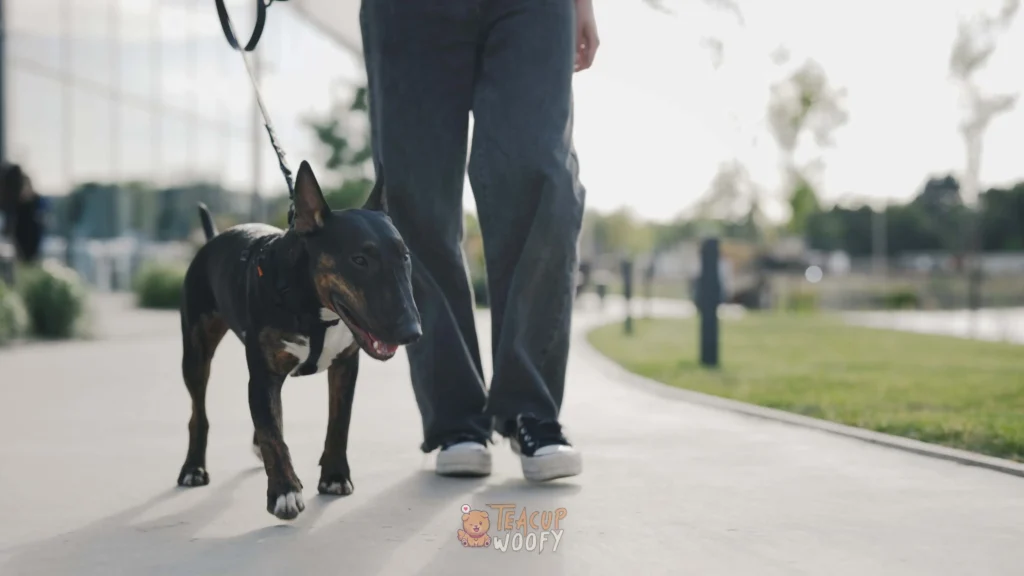
The story of the teacup bull terrier starts with the standard Bull Terrier, a breed that first appeared in England in the early 1800s. Originally, Bull Terriers were bred by crossing Bulldogs with Terriers, creating a dog that was tough, fearless, and full of personality. They were once used for bull-baiting and later as loyal companions and show dogs. By the mid-1800s, breeders refined the look we know today, the muscular body, egg-shaped head, and playful spirit.
Later on, the Miniature Bull Terrier emerged, bred specifically to be a smaller version of the standard without losing its boldness. The AKC officially recognized the Mini Bull Terrier in 1991, giving them their own place in the Terrier Group.
The teacup mini bull terrier, however, is a much more recent creation. Unlike the mini (which is standardized), “teacup” isn’t an official classification. Breeders created them by selectively pairing the smallest minis or, in some cases, crossbreeding to reduce size even more. The demand for teacup-sized dogs grew in the 2000s, especially in urban areas where smaller dogs are easier to manage in apartments.
While these pups carry the same mischievous and clownish spirit of their larger relatives, their smaller size comes with added risks. Anytime a breed is miniaturized beyond its natural standard, there can be higher chances of health problems. That’s why choosing a responsible breeder is so important if you’re considering a teacup bull terrier puppy for sale.
Size & Appearance of the Teacup Bull Terrier
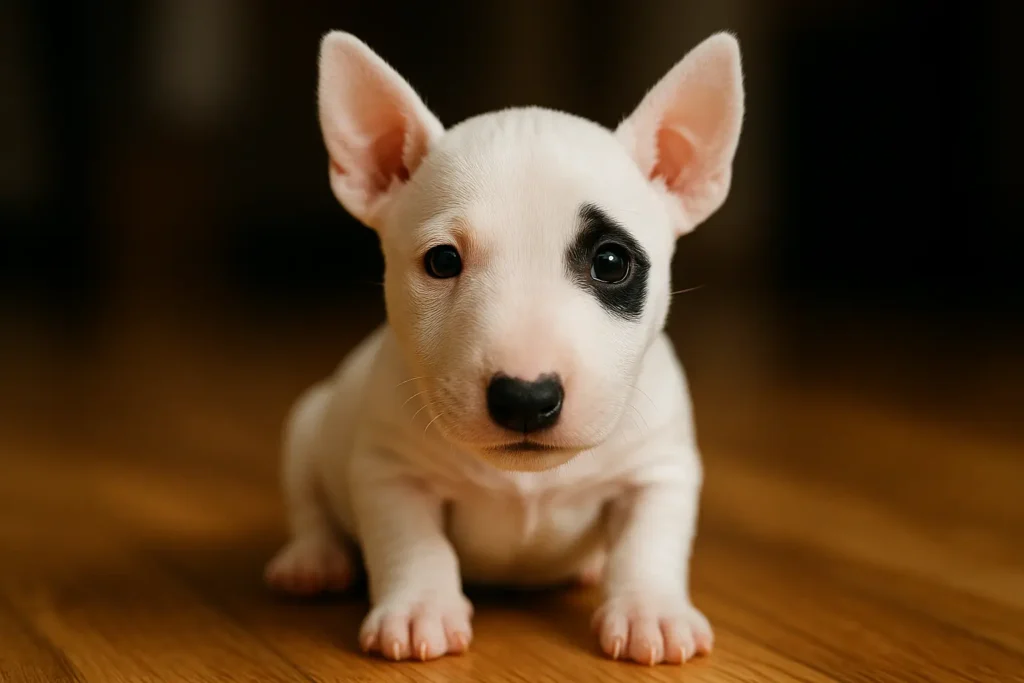
The teacup bull terrier (or teacup mini bull terrier) is basically a shrunken-down version of the standard Bull Terrier. They keep the same trademark egg-shaped head, strong jaw, and mischievous glint in their eyes, just in a much smaller, more portable package.
Coat Variants of the Dog
Teacup bull terriers, like their larger cousins, have a short, flat coat that’s smooth and easy to maintain. The coat comes in a variety of colors:
- Solid white
- White with markings (black, brindle, red, fawn, or tricolor)
- Solid colors like black, brindle, or red
Because of their fine coat, they don’t shed heavily, but they still lose a small amount year-round.
Dog Growth and Weight Chart
Since the “teacup” isn’t officially recognized, these numbers are estimates based on miniature Bull Terriers bred extra small.
Male Teacup Bull Terrier Growth
| Age | Average Weight | Height (shoulder) |
| 8 weeks | 3 – 4 lbs | 6 – 7 in |
| 3 months | 6 – 8 lbs | 8 – 9 in |
| 6 months | 9 – 13 lbs | 9 – 11 in |
| 9 months | 11 – 15 lbs | 10 – 12 in |
| 12 months (adult) | 13 – 20 lbs | 11 – 13 in |
Female Teacup Bull Terrier Growth
| Age | Average Weight | Height (shoulder) |
| 8 weeks | 2.5 – 3.5 lbs | 6 – 6.5 in |
| 3 months | 5 – 7 lbs | 7.5 – 8.5 in |
| 6 months | 8 – 11 lbs | 8.5 – 10 in |
| 9 months | 10 – 13 lbs | 9 – 11 in |
| 12 months (adult) | 12 – 18 lbs | 10 – 12 in |
When Will a Teacup Bull Terrier Stop Growing?
Most teacup Bull Terriers reach their full height by 9 to 10 months. They’ll continue to fill out in muscle and weight until around 12 months, sometimes up to 14 months. After their first birthday, they’re considered fully grown adults.
What Is the Size of a Full-Grown Dog?
A full-grown teacup bull terrier usually weighs 12 to 20 pounds and stands 10 to 13 inches tall at the shoulder. That makes them significantly smaller than the standard Bull Terrier (50–70 lbs, 20+ inches tall) and even smaller than most Miniature Bull Terriers (18–28 lbs, 10–14 inches tall).
Teacup Bull Terrier / Teacup Mini Bull Terrier Breed Overview
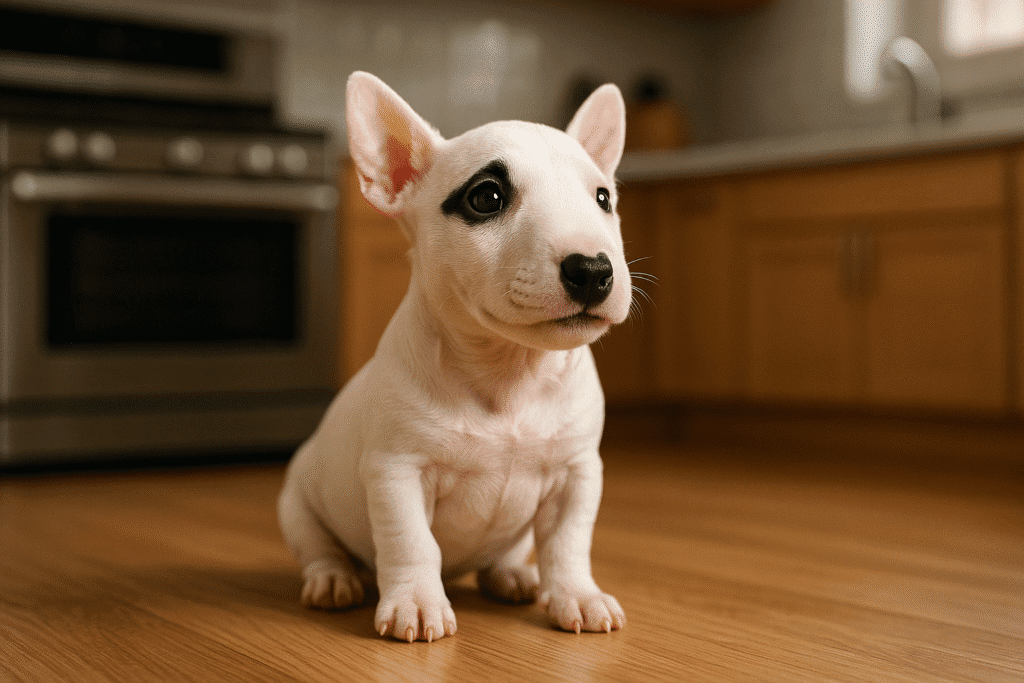
Here’s your quick snapshot of the teacup bull terrier, all the must-know details in one place.
Teacup Bull Terrier Size
Small but sturdy. On average, they weigh 12 to 20 pounds and stand about 10 to 13 inches tall at the shoulder when full-grown.
Teacup Bull Terrier Group
Not officially recognized by the AKC, but they fall under the companion dog/toy-size adaptation of the Terrier Group. The official Miniature Bull Terrier is recognized, while the “teacup” is considered more of a designer label.
Teacup Bull Terrier Height
- Males: 11–13 inches
- Females: 10–12 inches
Teacup Bull Terrier Weight
- Males: 13–20 pounds
- Females: 12–18 pounds
Teacup Bull Terrier Coat
Short, flat, and sleek. Easy to groom with minimal maintenance.
Teacup Bull Terrier Coat Colors
- Solid white
- White with black, brindle, fawn, or red markings
- Solid colors like black, red, brindle, or tricolor
(Source: AKC Bull Terrier Standard)
Teacup Bull Terrier Lifespan
On average, 11 to 14 years. With good care, teacups may live on the longer side, but selective miniaturization can introduce health risks.
Teacup Bull Terrier Temperament
- Playful and clownish
- Affectionate with family
- Bold and protective
- Stubborn at times, needs patient training
- Energetic, thrives with daily exercise
Teacup Bull Terrier Hypoallergenic?
No. They have short coats and shed lightly year-round, so they aren’t considered hypoallergenic.
Teacup Bull Terrier Origin
- Standard Bull Terrier: Bred in 19th-century England from Bulldogs and Terriers.
- Miniature Bull Terrier: Developed to be a smaller companion version, officially recognized in 1991 by AKC.
- Teacup Bull Terrier: A modern adaptation bred by selecting the smallest minis or crossbreeding for size.
Teacup Bull Terrier Price
Teacup bull terriers are rare and pricey. Expect to pay $2,000 to $4,500 USD depending on breeder, coat color, and pedigree. Puppies advertised as “teacup bull terrier for sale” often come at premium prices.
Average Monthly Expenses
- Food: $30–$60
- Grooming: $20–$50 (short coat = low grooming cost)
- Veterinary: $60–$120 (averaged monthly for checkups, vaccines, and preventatives)
- Misc (toys, treats, training): $20–$40
On average, you’re looking at $130 to $250 per month to care for a teacup bull terrier.
Teacup Bull Terrier Breed Characteristics
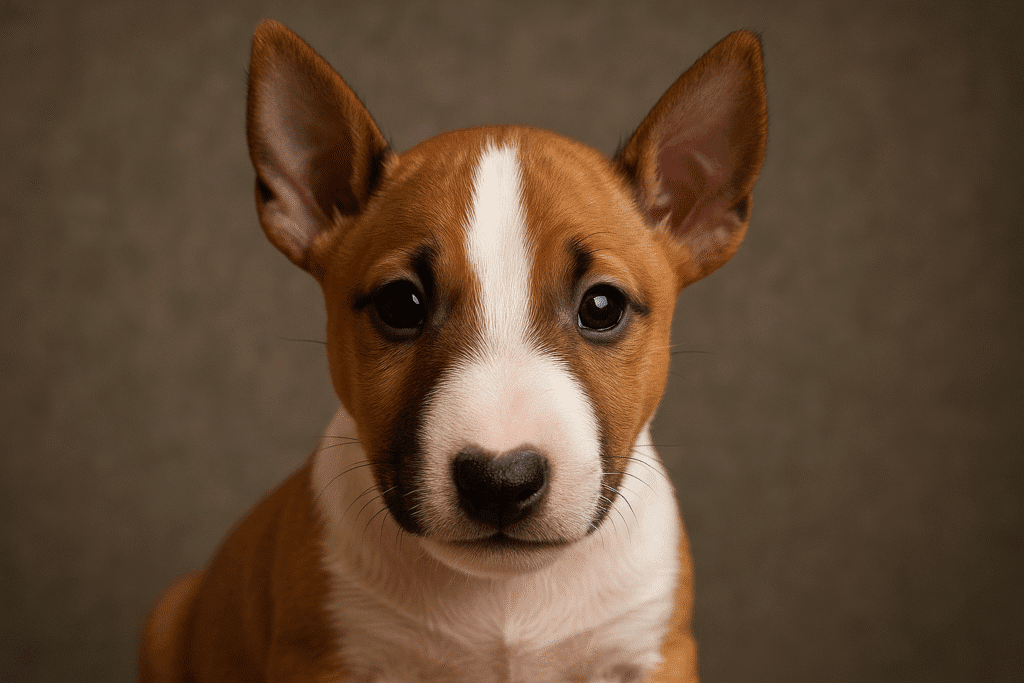
The teacup bull terrier may be small in size, but don’t let that fool you, this little pup packs a big personality. If you’re curious about what they’re like as companions, here’s a breakdown of their key characteristics.
Affection Level
High. Teacup bull terriers are loyal and love being part of the family. They’ll happily curl up next to you after a play session.
Friendliness
Moderate. They’re warm and loving toward their people but can be reserved around strangers until they feel comfortable.
Kid-Friendly
Good with older kids who know how to play gently. Their playful energy makes them fun, but small bones mean roughhousing with toddlers isn’t ideal.
Pet-Friendly
Moderate. They can live with other dogs if socialized early, but they sometimes prefer being the star of the show. Supervision with cats or small pets is recommended due to a moderate prey drive.
Exercise Needs
Moderate to high. They may be small, but they’ve got energy to burn. Expect 30–45 minutes of activity daily to keep them happy.
Playfulness
Very high. They’re little clowns, always ready to play and make you laugh. They’re known for their silly antics and goofy charm.
Energy Level
High. Teacup bull terriers are active and need both mental and physical stimulation. Without it, they can become bored and mischievous.
Health
Fair. Miniaturization can bring risks like joint issues, dental problems, and heart concerns. Regular vet checkups are essential.
Sociability
Moderate. Early socialization helps them grow into well-rounded dogs. They can be protective of their families but need positive exposure to people and pets.
Trainability
Moderate. Smart, but stubborn. They require patient, consistent training with positive reinforcement.
Intelligence
High. They’re quick thinkers and problem-solvers, though sometimes they’ll use that brainpower to get into trouble.
Tendency to Bark
Moderate. They’ll bark to alert you or when excited, but they’re not known as constant yappers.
Amount of Shedding
Low to moderate. Their short coats shed lightly year-round, and weekly brushing usually keeps it under control.
Temperament and Personality of the Teacup Bull Terrier
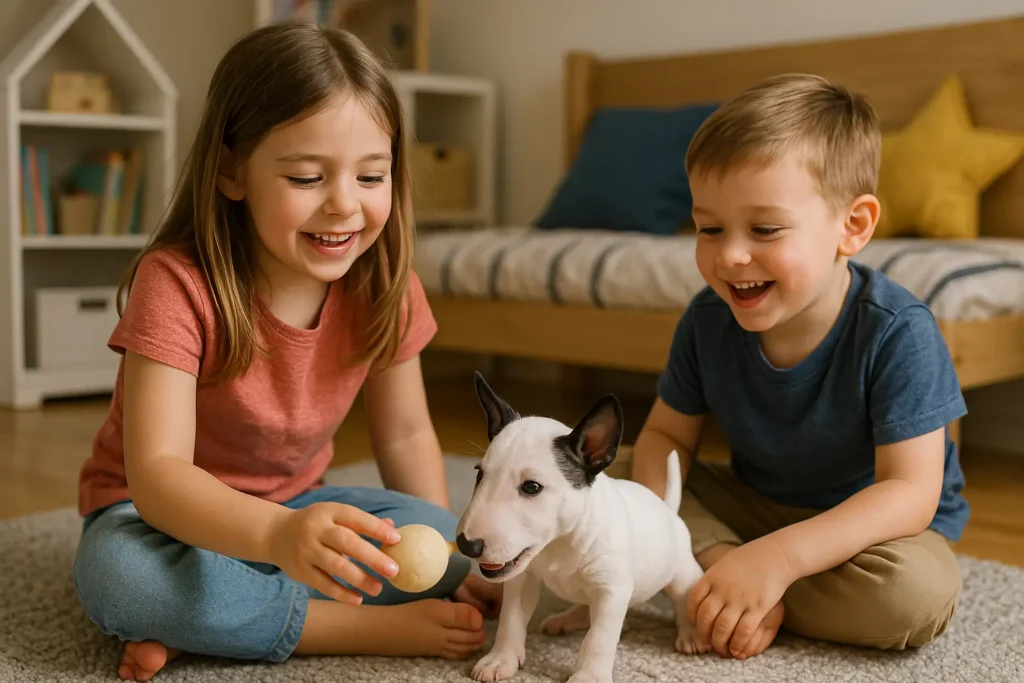
If I had to describe the teacup bull terrier in one phrase, it would be “tiny clown with a big heart.” These little dogs might be small in size, but their personalities are larger than life.
Playful and Mischievous
Teacup bull terriers are natural-born goofballs. They’ll chase their tails, zoom around the living room, and come up with silly antics just to make you laugh. They thrive on play and attention, and honestly, their sense of humor is one of the reasons people fall in love with them.
Affectionate and Loyal
Despite their mischievous streak, they’re incredibly loyal. Once they bond with you, they want to be where you are. They’re not the kind of dog that likes being ignored, they’ll nudge you, climb onto your lap, or drop a toy at your feet to remind you they’re there.
Bold and Confident
Even in their pint-sized form, teacup bull terriers carry themselves like they own the room. They’re confident, sometimes a little too confident, which can come across as stubbornness. That bold nature makes them protective of their families and surprisingly good watchdogs for such small dogs.
Stubborn but Smart
Let’s be real, training a teacup bull terrier can test your patience. They’re smart enough to learn quickly, but their independent streak means they’ll sometimes act like they know better. Positive reinforcement, consistency, and a good sense of humor are absolute musts.
Family Companions
With older kids and families who understand their energy, teacup bull terriers can be fantastic companions. They love being part of the action and hate being left out. But because they’re small and full of energy, they need supervision around toddlers who might play too rough.
Teacup Bull Terrier Behavior
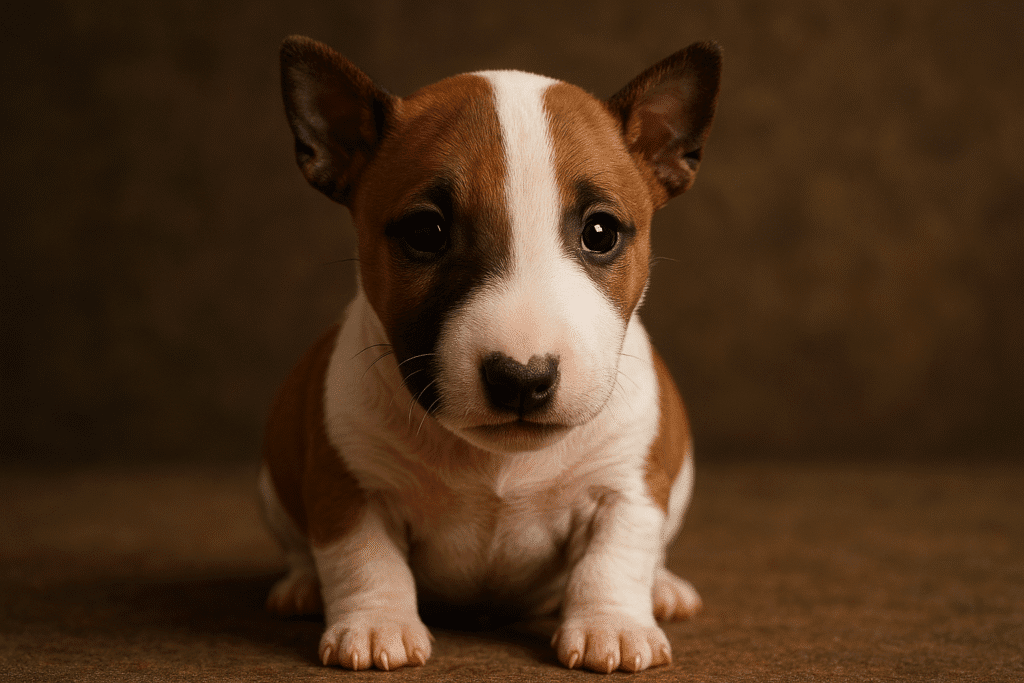
Living with a teacup bull terrier is like sharing your home with a little comedian who never runs out of energy or curiosity. Their behavior is bold, silly, and sometimes a bit stubborn, which is exactly what makes them so lovable.
Everyday Behavior
Teacup bull terriers are busy dogs. They love exploring, chasing toys, and sometimes even getting into a bit of mischief if they’re bored. Don’t be surprised if you catch yours carrying shoes around the house or inventing their own “games.”
With Family
They thrive on attention and want to be part of everything you’re doing. Whether you’re watching TV, cooking, or working from home, they’ll be right there underfoot. They’re affectionate but not clingy, more like your cheeky sidekick than a shadow.
With Strangers
Around strangers, teacup bull terriers can be curious but cautious. They’ll bark to let you know someone new is around, but with proper introductions, they usually warm up quickly. Socialization from a young age helps prevent them from becoming too protective.
With Other Pets
If raised with other dogs, they can get along just fine, though they often like being the star of the show. Their terrier instincts give them a moderate prey drive, so cats and small animals might not appreciate their enthusiasm.
Training and Discipline
Consistency is everything. These dogs are clever but stubborn, so training should be firm but positive. They respond best to treats, play, and lots of praise. Harsh corrections don’t work and usually backfire.
Cost of Buying vs Adopting a Bull Terrier Teacup
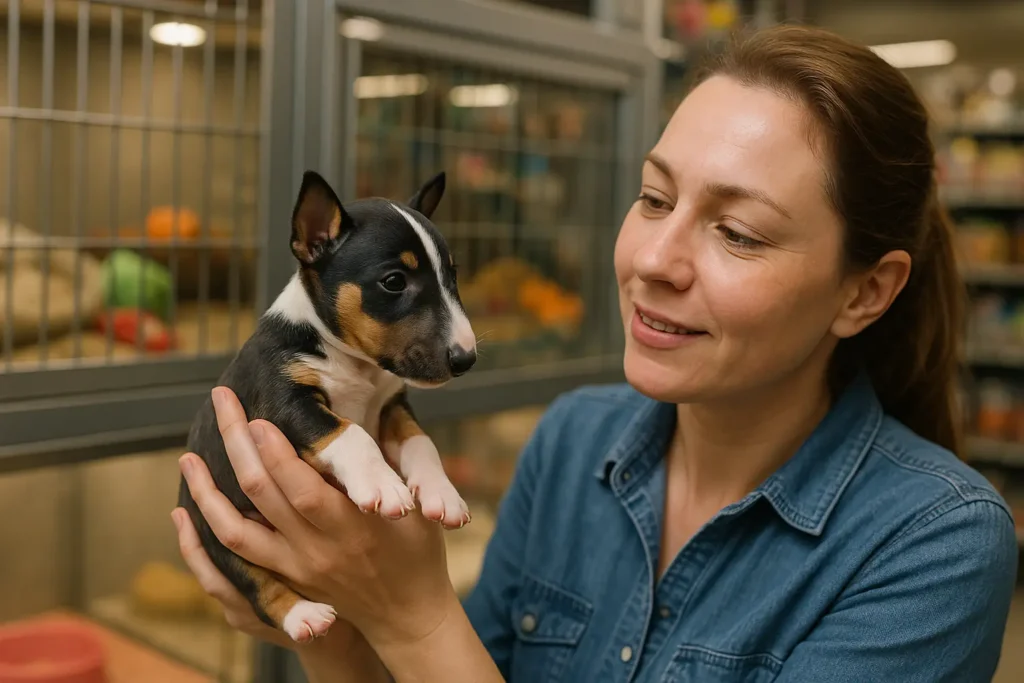
Buying from a breeder:
- A regular Bull Terrier puppy typically costs $1,800 to $3,000 USD depending on breeder reputation, lineage, region, etc. Dogster
- Miniature Bull Terrier puppies from reputable breeders often go for $2,500-$4,500 USD.
- In listings, some Miniature Bull Terrier puppies appear for lower or higher than that range depending on color, demand, breeder, quality, etc. For example, certain miniature pups show up around $1,500-$2,500, some more.
Adopting / Rehoming:
- Adoption fees for Miniature Bull Terriers (or similar bull terrier types) in shelters/rescues are much lower, often $50 to $300 USD. These fees usually include basic vaccinations, spaying/neutering, microchipping.
- Sometimes you may see slightly higher adoption fees in private rescues or breed-specific rescue organizations. Costs can go up when more medical care or special conditions are involved.
Monthly Expenses for a Teacup Mini Bull Terrier
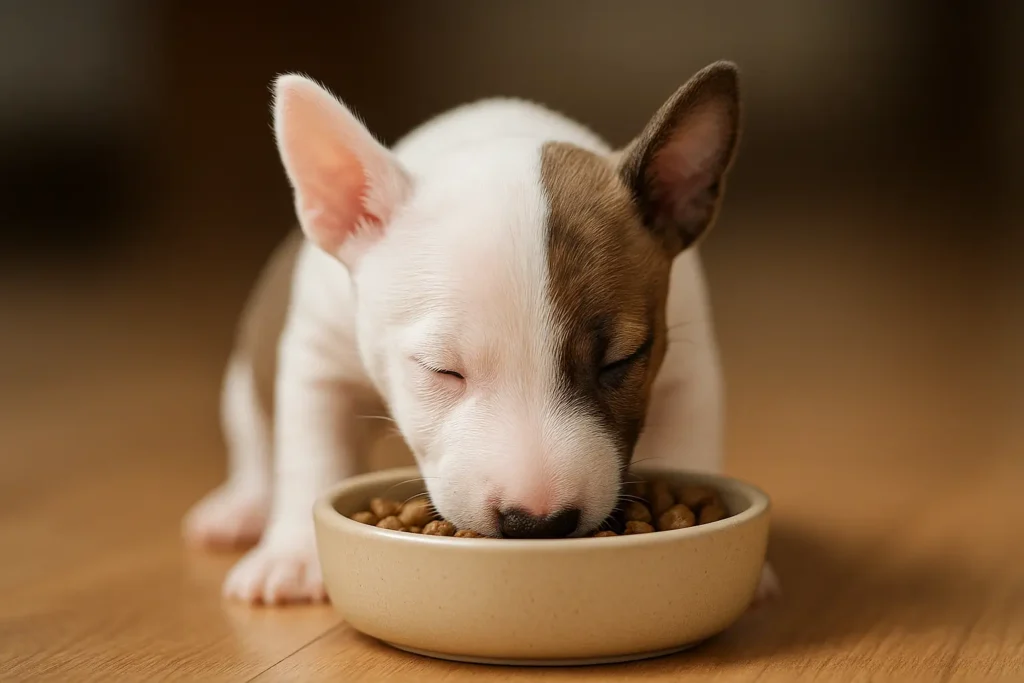
Food
- Because teacup mini Bull Terriers are small, they eat less than larger dogs. For many Miniature Bull Terriers, food alone often runs $30-$37.50/month when feeding a good quality dry kibble.
- If you use premium brands, add wet food, special dietary formulas, or supplements, expect that number to creep higher (perhaps $50-$70 or more, depending on what you choose).
Veterinary Care
- Routine vet costs (annual checkups, core vaccines, flea/tick/heartworm prevention) divided over 12 months often come to $50-$80/month for small breeds. Bull Terriers typically have those kinds of vet expenses. iHeartDogs+1
- If your pup has extra health needs, age-related issues, or requires specialized care, veterinary costs may spike in some months.
Grooming
- Since a teacup mini Bull Terrier has a short flat coat, grooming is simpler than long-haired breeds. A basic grooming session (bath, brush, nail trim, ear cleaning) for a small dog typically costs $30-$50 per session.
- If you get full grooming more frequently or pamper them with mobile groomers or extra services (deshedding, teeth, specialty trims), the grooming cost could be $60-$100/month in some cases.
Rough Total Estimate
Putting those together, here’s what you might budget monthly:
- Food: $30-$50
- Veterinary: $50-$80
- Grooming: $30-$60
So you’re looking at roughly $110 to $190/month for just those three categories, for a healthy teacup mini Bull Terrier.
Diet and Nutrition for a Teacup Mini Bull Terrier
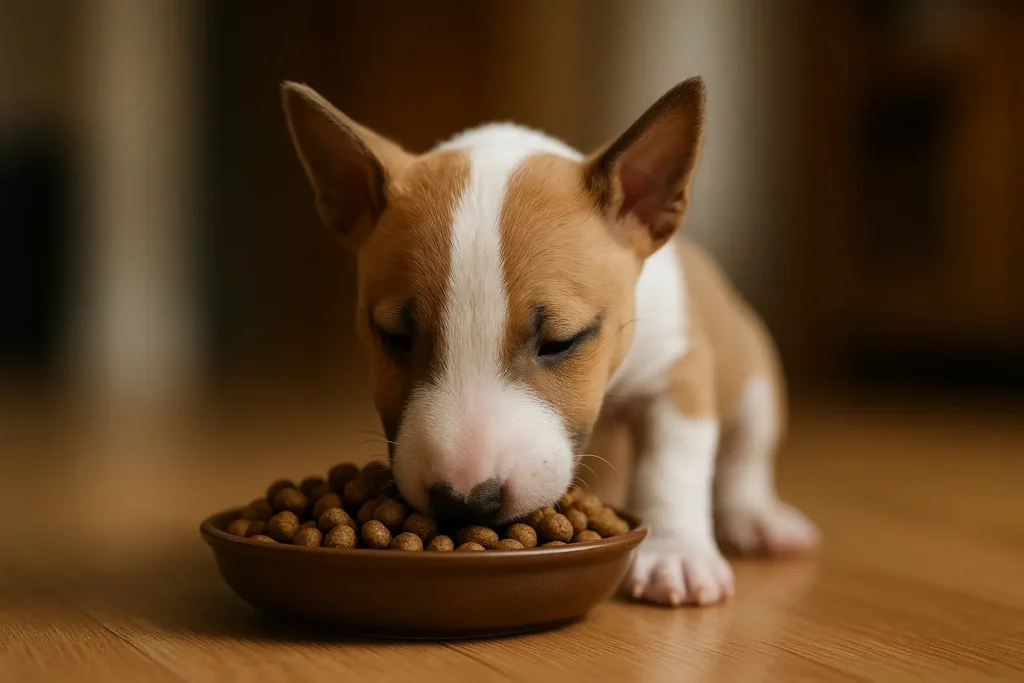
Feeding a teacup mini Bull Terrier the right way makes all the difference for their health, energy, and that shiny little coat. These pups are small, but they’re also muscular and active, so their diet has to be balanced and nutrient-rich.
Monthly Food Expenses
On average, you’ll spend about $30 to $50 per month on high-quality small-breed dog food. If you opt for premium kibble, wet food, or fresh food diets, that cost can rise to $60–$70 per month.
Essential Nutrients
A healthy diet should include:
- Protein: Builds strong muscles (look for at least 22–25% in puppy food, 18–22% in adult formulas).
- Healthy fats: 8–12% for pups, 5–8% for adults, fuels their energy and keeps coats sleek.
- Carbohydrates: Whole grains, sweet potatoes, or brown rice for energy.
- Vitamins & minerals: Calcium, phosphorus, and antioxidants for bone, heart, and immune support.
- Omega-3 & Omega-6: Helps reduce inflammation and supports skin health.
Best Foods for Puppies
- High-quality small-breed puppy kibble (Royal Canin Small Puppy or Blue Buffalo Life Protection Puppy or Hill’s Science Diet Small Paws).
- Wet puppy food or softened kibble for easier chewing.
- Occasional toppers like boiled chicken, salmon, or pumpkin (in moderation).
How much to feed:
- Puppies should eat 3–4 small meals per day.
- Total daily amount: about ¼ to ½ cup of dry food, depending on age and weight.
Best Foods for Adults
- Small-breed adult formulas (Wellness CORE Small Breed, Merrick Lil’ Plates, Orijen Small Breed).
- Lean proteins like chicken, turkey, or fish.
- Cooked vegetables such as carrots, peas, and sweet potato.
How much to feed:
- Adults should eat 2 meals per day.
- Total daily amount: around ½ to 1 cup of dry food, adjusted for weight and activity level.
Calories per Day
- Puppies: 300–450 calories per day (spread over multiple meals).
- Adults: 250–400 calories per day, depending on size and energy.
As a guide, small dogs need roughly 40 calories per pound of body weight daily.
Breakdown of Macronutrients
- Protein: 22–25% for puppies, 18–22% for adults
- Fat: 8–12% for puppies, 5–8% for adults
- Carbs: 40–50% (preferably from healthy sources)
- Fiber: 3–5% for digestion
Never Feed These Foods
- Chocolate
- Grapes & raisins
- Onions & garlic
- Xylitol (sugar-free gum or peanut butter)
- Cooked bones
- Alcohol or caffeine
- Fatty or salty foods
Nutritional Tips
- Stick to a feeding schedule instead of free-feeding to avoid obesity.
- Always provide fresh water.
- Use small-breed kibble so they can chew easily.
- Treats should be no more than 10% of daily calories.
- Add fish oil or omega supplements for skin and coat health.
- Introduce new foods gradually to avoid tummy upsets.
Health of the Teacup Bull Terrier

Caring for the health of a teacup bull terrier is more than just trips to the vet, it’s about building routines that keep them thriving. These little comedians may be small, but they’re active, bold, and sometimes prone to certain health concerns. Here’s what you should know.
Average Monthly Expenses
On average, expect to spend $50–$100 per month on veterinary-related costs when averaged out across a year. This includes:
- Routine checkups
- Vaccinations
- Flea/tick and heartworm prevention
- Dental cleanings (very important for small breeds)
Emergencies or chronic issues can increase costs, so many owners invest in pet insurance for peace of mind.
Overall Well-Being
A healthy teacup bull terrier is playful, bright-eyed, and full of energy. They need a balance of physical activity, mental stimulation, and proper nutrition to stay happy. Keeping a daily routine (feeding, exercise, training) helps reduce stress and keeps their behavior in check.
Common Health Problems
Because of their miniaturized size, teacup bull terriers may face:
- Dental disease: Overcrowded teeth and gum issues.
- Luxating patella: Knee cap slips, common in toy breeds.
- Heart conditions: Risk of congenital heart problems.
- Hypoglycemia: Low blood sugar in young pups if meals are skipped.
- Skin allergies: Their short coats can make them prone to irritations.
Energy Level
Teacup bull terriers are high-energy dogs for their size. They love to play and need daily activity to burn off energy. Without it, they can become bored and act out with destructive behaviors.
Recognizing Stress
Signs your pup might be stressed include:
- Excessive barking or whining
- Pacing or restlessness
- Panting more than usual
- Chewing or destructive behavior
- Avoiding interaction or hiding
Calm reassurance, exercise, and mental stimulation (like puzzle toys) help ease stress.
Medical Care
- Puppies: Vet visits every few weeks until vaccinations are complete.
- Adults: At least once a year for exams, dental checks, and boosters.
- Seniors: Every 6 months for bloodwork, weight monitoring, and preventive care.
Vaccination Details
Standard vaccinations follow the small-breed schedule:
- Core vaccines: Rabies, Distemper, Parvovirus, Adenovirus
- Lifestyle vaccines: Bordetella, Lyme, Leptospirosis (if risk factors exist)
- Puppies: Start at 6–8 weeks, boosters every 3–4 weeks until 16 weeks
- Adults: Boosters every 1–3 years depending on the vaccine and vet’s advice
(Source: AVMA)
Caring for a Senior Teacup Bull Terrier
As your little clown ages (around 8+ years), their care needs change:
- Switch to senior dog food with joint support and fewer calories.
- Add supplements like glucosamine and omega-3s for joints and coat.
- Schedule vet visits every 6 months to catch issues early.
- Keep exercise gentle but regular, short walks and light play are ideal.
- Provide comfy bedding and a calm routine to keep them comfortable.
Care & Exercise Needs of the Teacup Bull Terrier
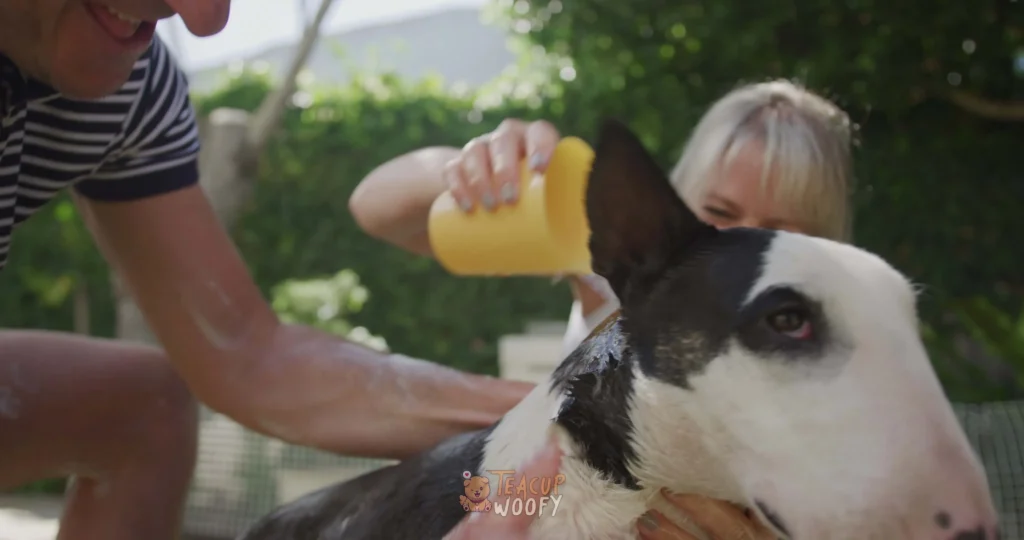
When it comes to exercise, the teacup bull terrier may be small, but don’t let that fool you, these pups are packed with energy. If you don’t give them a healthy outlet, they’ll find their own entertainment (like chewing shoes or zooming across the couch cushions).
High Energy Level
Teacup bull terriers are very energetic for their size. They’re natural athletes in little bodies, so they need regular activity to keep both their minds and muscles busy.
Intensity
Their play and exercise style is pretty intense compared to many other toy-sized dogs. Expect bursts of energy, quick sprints, and enthusiastic play. They’re not couch potatoes, and they won’t be satisfied with just a short potty break outside.
Exercise Needs
Plan for at least 30–45 minutes of exercise per day. This can be split into shorter sessions:
- Morning and evening walks
- A game of fetch or tug-of-war
- Puzzle toys or training exercises indoors
Potential for Playfulness
Through the roof! Teacup bull terriers are natural clowns. They’ll chase balls, carry toys around, and invent silly games to get your attention. This playfulness is one of their most endearing traits, but it also means they can become mischievous if bored.
Exercise Routine
Here’s a sample daily routine for a healthy teacup bull terrier:
- Morning: 15–20 min brisk walk
- Midday: Short play session indoors or in a safe yard (fetch, tug, or training)
- Evening: 20–25 min walk plus puzzle toys or brain games
The key is consistency. A tired bull terrier is a happy (and well-behaved) bull terrier.
Shedding: Teacup Mini Bull Terrier
When it comes to shedding, the teacup mini bull terrier is on the easier side compared to fluffy breeds like Chows or Poms. Their short, sleek coat makes maintenance simple, but that doesn’t mean they’re completely shed-free.
Shedding Level
- Low to Moderate: Teacup mini bull terriers shed lightly all year round. You’ll notice a bit of hair on furniture and clothes, but nothing overwhelming.
- Seasonal Shedding: During spring and fall, they may shed more as their coat adjusts to the weather, but it’s still manageable with regular brushing.
- Easy Coat Care: Because their hair is short and fine, it doesn’t mat or tangle, and a quick brush once or twice a week keeps shedding under control.
Grooming the Teacup Mini Bull Terrier
The teacup mini bull terrier may have a short, sleek coat, but that doesn’t mean grooming is optional. Regular care keeps their skin healthy, their coat shiny, and their overall well-being in top shape.
Average Monthly Expenses
Because they’re low-maintenance compared to fluffy breeds, grooming costs are on the lighter side:
- At-home care: Around $20–$30/month for brushes, wipes, shampoos, and nail clippers.
- Professional grooming: About $30–$50 per session, which you might only need every 1–2 months.
On average, expect $20–$50/month, depending on how much you do yourself versus the groomer.
Benefits of Grooming
- Reduces shedding and keeps your home cleaner
- Prevents skin problems and hot spots
- Keeps ears and eyes free from infection
- Maintains healthy nails and proper walking posture
- Strengthens the bond between you and your dog
Hygienic Checklist
Here’s a simple routine to keep your pup fresh and clean:
- Weekly brushing with a soft bristle brush or grooming mitt
- Bath every 4–6 weeks (or sooner if muddy)
- Weekly ear checks and cleaning
- Daily teeth brushing or dental chews
- Nail trim every 3–4 weeks
- Eye wipe as needed to prevent buildup
Skin Care
Bull terriers can be prone to skin allergies. Use gentle, hypoallergenic shampoos and avoid over-bathing, which can dry out their skin. Adding omega-3 supplements also helps maintain healthy skin.
Coat Care
Their short coat is easy to maintain, a weekly brushing removes loose hair and distributes natural oils, leaving it glossy and smooth.
Eye Care
Check eyes weekly for redness, discharge, or cloudiness. Wipe gently with a damp cloth or pet-safe eye wipe if you notice any gunk.
Nail Care
Trim nails every 3–4 weeks. If you hear clicking on the floor, it’s time for a trim. Short nails prevent discomfort and joint stress.
Adaptability of the Teacup Bull Terrier
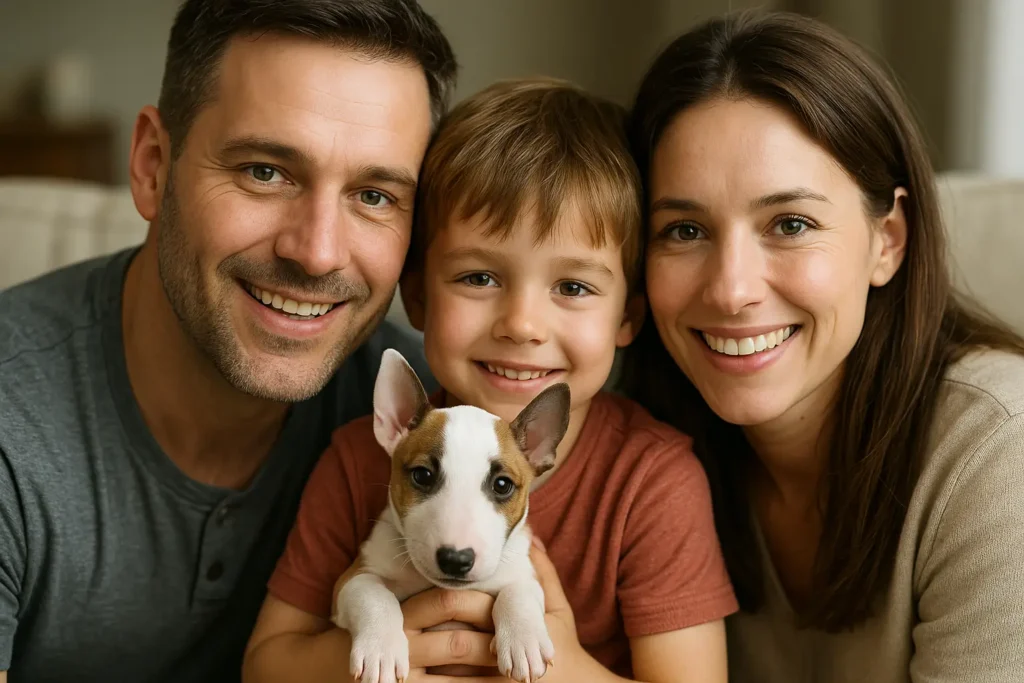
When it comes to adapting to different homes and lifestyles, the teacup bull terrier does surprisingly well, as long as their exercise and attention needs are met. Here’s a full breakdown.
Adapts Well to Apartment Living
Yes, teacup bull terriers can thrive in apartments. Their small size makes them manageable in smaller spaces, but don’t forget they’re energetic dogs. Daily walks and interactive play are non-negotiable to keep them happy and prevent restlessness.
Tendency to Bark or Howl
They’re moderate barkers. They’ll alert you to strangers or unusual noises, but they’re not known for constant yapping. Proper training and socialization help keep barking under control.
Good for Novice Dog Owners
Teacup bull terriers aren’t the easiest choice for first-time dog parents. Their stubborn streak and high energy require patience, consistency, and firm but gentle training. A novice can manage, but only if they’re committed to structured routines and positive reinforcement.
Sensitivity Level
They’re fairly sensitive dogs. Harsh discipline or yelling will shut them down quickly. They respond best to encouragement, praise, and rewards.
Tolerates Being Alone
They don’t like being left alone for long periods. While they can handle a few hours, too much isolation can lead to destructive behavior (like chewing furniture) or anxiety. Mental stimulation, puzzle toys, chew toys, helps keep them occupied when you’re away.
Tolerates Cold Weather
Because of their short, thin coat, teacup bull terriers don’t tolerate cold very well. They’ll need sweaters or jackets for chilly walks, and shouldn’t be left outside in low temperatures.
Tolerates Hot Weather
They tolerate heat better than cold, but their compact, muscular build makes them prone to overheating if exercised too hard in hot weather. Always provide shade, fresh water, and limit exercise during peak sun hours.
All-Around Friendliness of the Teacup Bull Terrier
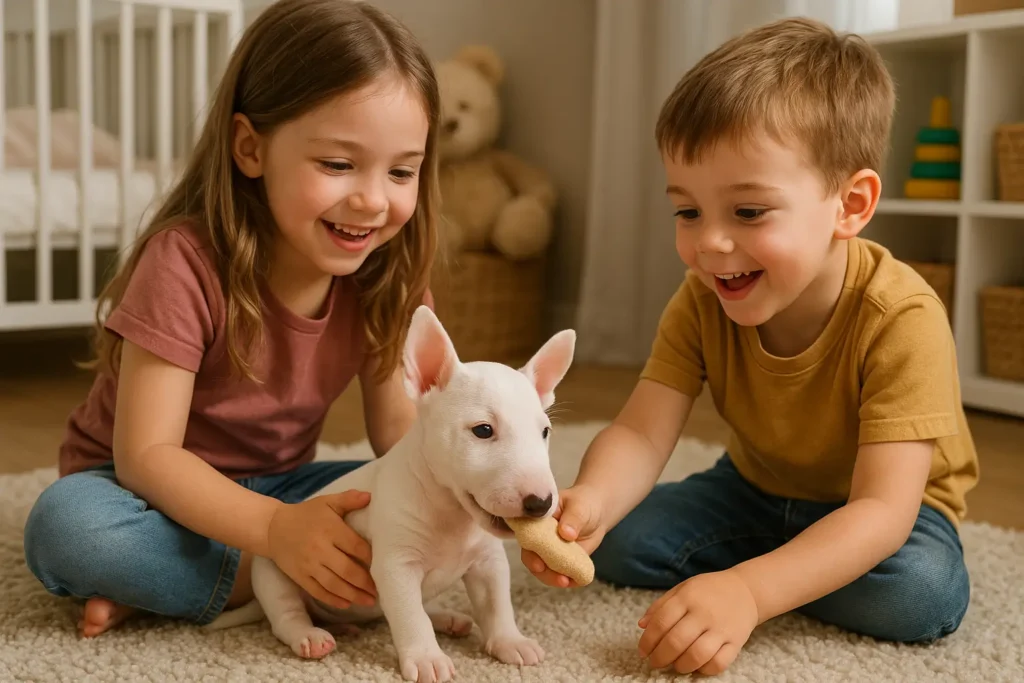
The teacup bull terrier may be small, but their personality is big, bold, and full of charm. When it comes to friendliness, they can be wonderful companions, though their playful, stubborn nature means they’re not always a perfect match for every home.
Best Family Dogs
Teacup bull terriers can be excellent family pets when raised with consistent training and socialization. They thrive in active households where they’re included in daily life, but they may struggle in very quiet homes where they don’t get enough stimulation.
Kid-Friendly
These pups are typically good with older kids who understand how to play gently. Their energy and clownish personality make them fun companions, but their small bodies are still sturdy, which means they might not tolerate rough handling from toddlers. Teaching kids how to respect boundaries is key.
Dog Friendly
With proper introductions and early socialization, teacup bull terriers can get along with other dogs. They sometimes have a “center of attention” streak, so supervision is wise in multi-dog households. Their moderate prey drive means smaller pets like rabbits or hamsters may not be safe playmates.
Friendly Towards Strangers
Naturally curious, teacup bull terriers are usually polite but cautious around strangers. They may bark when someone new comes to the door but tend to warm up once they see there’s no threat. With good socialization, they can become more relaxed and friendly in public.
Trainability of the Teacup Bull Terrier
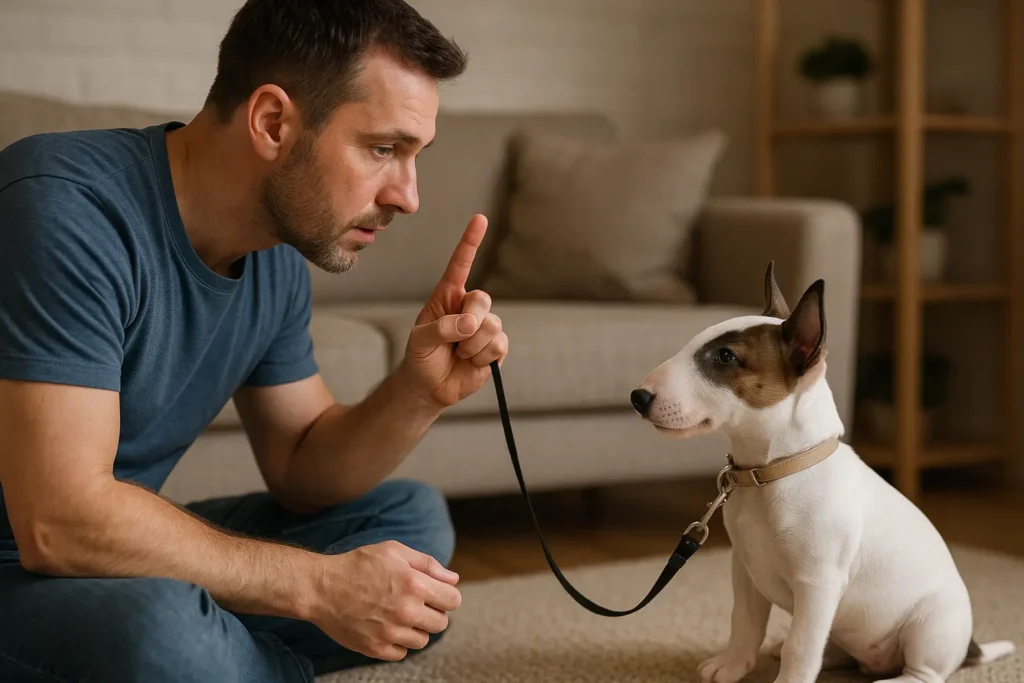
Training a teacup bull terrier can be both rewarding and challenging. They’re clever little dogs, full of personality, but that same bold streak means they don’t always like being told what to do.
Easy to Train
Teacup bull terriers are not the easiest dogs to train. They’re smart enough to learn quickly, but their stubborn nature can get in the way. Consistency, patience, and positive reinforcement (think treats, toys, and praise) work far better than harsh methods, which will only make them shut down.
Intelligence
These pups are sharp thinkers. They love solving problems and can pick up commands with practice. The flip side is they may use that intelligence to test boundaries, like figuring out how to open cabinets or sneak onto the couch when you’re not looking.
Potential for Mouthiness
Like many terrier breeds, teacup bull terriers may go through a mouthy puppy phase. They’ll nip or chew while playing, but with redirection to chew toys and consistent training, most outgrow this habit.
Prey Drive
They have a moderate prey drive. Fast-moving animals like squirrels or smaller pets may trigger their instincts. It’s best to keep them on a leash outside and supervise interactions with small pets indoors.
Wanderlust Potential
Unlike some breeds that love to roam, teacup bull terriers don’t have a strong wanderlust streak. They’re bold and curious, but they prefer sticking close to their people. Still, a secure yard or leash is important to keep them safe from distractions.
Teacup Bull Terrier Puppies
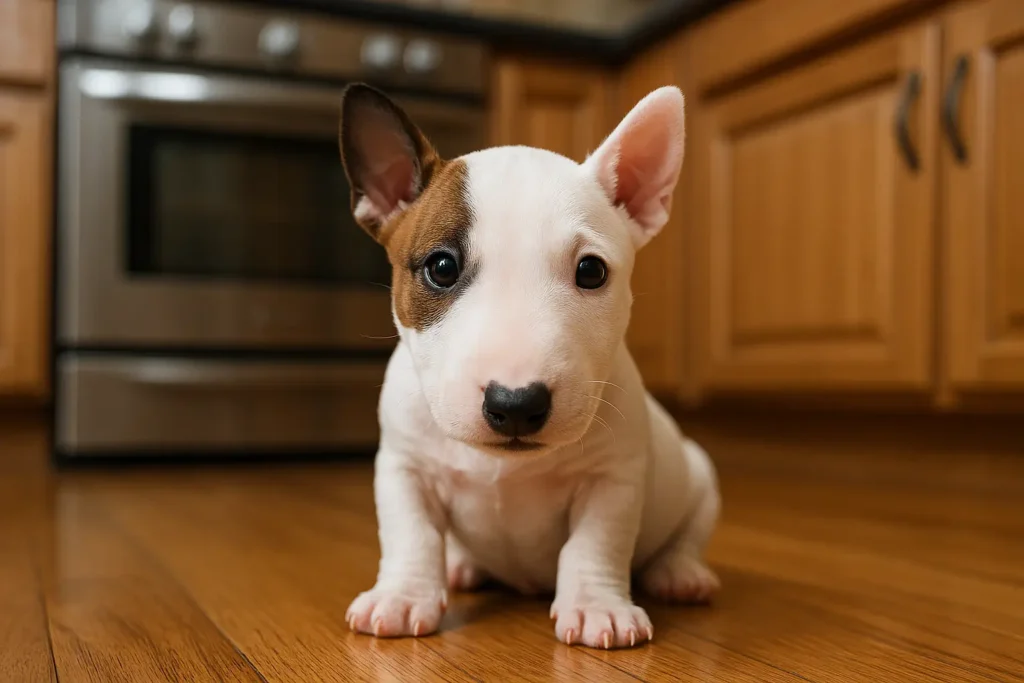
There’s nothing quite like a teacup bull terrier puppy, they’re tiny, quirky, and full of mischief from day one. If you’ve ever seen one, you know they look like mini egg-headed clowns with oversized personalities in pint-sized bodies.
Puppies’ Size
Teacup bull terrier puppies start off incredibly small compared to standard Bull Terrier pups:
- At birth: Just a few ounces
- 8 weeks old: Around 2.5 – 4 pounds
- 3 months old: Typically 5 – 8 pounds
- 6 months old: About 8 – 12 pounds
By their first birthday, most teacup bull terriers are considered fully grown, weighing between 12 – 20 pounds and standing 10 – 13 inches tall.
Male vs Female Teacup Bull Terriers
When choosing between a male and female teacup bull terrier, the differences aren’t extreme, but there are a few things worth knowing. Both share that bold, clownish personality, but subtle variations in size and temperament can influence which one is the better fit for your home.
Size Differences
- Males: Typically a little larger, reaching 13–20 pounds and standing around 11–13 inches tall.
- Females: Slightly smaller, averaging 12–18 pounds and about 10–12 inches in height.
While both are small, males often look more muscular and stocky compared to the leaner frame of females.
Temperament
- Males: Tend to be more playful, goofy, and affectionate. They may be more demanding of attention, acting like the class clown of the family.
- Females: Often more independent and focused. They can be affectionate too but may show it in quieter, more reserved ways. Some owners describe them as a little “sassier” or moody at times.
Trainability
- Males: Sometimes test boundaries more often, especially during puppyhood. Training can take extra patience and consistency.
- Females: Usually a touch more cooperative, though they can also be stubborn in their own way.
Which Is Better for Families?
- Males: Great for families wanting a fun-loving, interactive dog that enjoys lots of play.
- Females: A better fit for owners who prefer a calmer, slightly more independent companion.
What to Know Before You Buy or Rehome a Teacup Bull Terrier
Before bringing a teacup bull terrier into your life, it’s important to understand what you’re really signing up for. These little dogs may be small, but their needs, and their personalities, are big. Here are the key things you should consider before you buy or rehome one.
1. “Teacup” Is Not Official
The teacup bull terrier is not a recognized size by kennel clubs like the AKC. Breeders use the term “teacup” to describe smaller-than-average Miniature Bull Terriers. Sometimes this comes from selective breeding of the smallest pups, which can increase the risk of genetic health issues. Always ask questions about lineage and breeding practices.
2. Health Risks Are Higher
Miniaturized dogs often face unique health challenges. In teacup bull terriers, these can include:
- Dental crowding (tiny jaws = crooked or crowded teeth)
- Joint problems such as patellar luxation
- Hypoglycemia in puppies if meals are skipped
- Skin allergies and sensitivities
- Heart problems in poorly bred lines
A reputable breeder should provide health screenings and vet certificates. If they can’t, walk away.
3. Costs to Expect
Buying a teacup bull terrier isn’t cheap. Prices usually fall between $2,000 and $4,500 USD, depending on breeder reputation, coat color, and pedigree. On top of that, expect monthly expenses of $110 to $190 for food, grooming, and vet care. Adoption fees are much lower (usually $50–$300) but teacup-sized dogs are rare in rescues.
4. Lifestyle Match
Teacup bull terriers are playful, high-energy, and stubborn. They need:
- Daily exercise (30–45 minutes)
- Consistent training and positive reinforcement
- Mental stimulation through toys and interaction
- A family that enjoys having a funny, bold, sometimes mischievous little companion
They don’t do well with long periods of isolation and can develop destructive habits if bored.
5. Adoption vs Buying
- Adoption: Saves a life, costs less, and often comes with basic vetting included. Perfect if you’re open to size/age flexibility.
- Buying: Gives you control over age, size, and (sometimes) color, but comes at a high cost. Be sure to choose a breeder who prioritizes health over looks.
10 Facts About the Teacup Bull Terrier
The teacup bull terrier is small in size but big in personality. If you’re curious about what makes this little clown dog so unique, here are ten fun and important facts.
- Not an Official Size: The “teacup” bull terrier isn’t recognized by the AKC or other kennel clubs. It’s a selectively bred version of the Miniature Bull Terrier, chosen for being extra small.
- English Roots: All bull terriers trace back to 19th-century England, where Bulldogs were crossed with terriers to create a strong, confident, and entertaining companion.
- Egg-Shaped Head: Even in tiny form, the teacup bull terrier keeps the breed’s signature “egg-shaped” head and triangular eyes, one of the most iconic looks in the dog world.
- Small but Mighty: Full-grown teacup bull terriers weigh 12–20 pounds and stand 10–13 inches tall, making them sturdier than many toy breeds.
- Coat Colors: They come in a variety of shades: solid white, white with black or brindle patches, or solid colors like red, black, or brindle.
- Little Clowns: Nicknamed the “clowns of the dog world,” bull terriers are famously playful and mischievous. Teacups carry the same fun-loving personality in a smaller frame.
- High Energy: Don’t let their size fool you, they need 30–45 minutes of exercise daily to burn off energy and stay well-behaved.
- Family Companions: They bond closely with their people and love being included in family activities, though they’re best with older kids who know how to handle dogs gently.
- Health Watch: Because of selective breeding for size, teacup bull terriers can be prone to joint issues, dental problems, and skin allergies, regular vet visits are a must.
- Pricey Pups: These dogs are rare and in demand, so prices typically range from $2,000 to $4,500 USD. Adoption is far cheaper, but finding a teacup bull terrier in a rescue is uncommon.
Summary: Teacup Bull Terrier
The teacup bull terrier is a pint-sized version of one of the most iconic dog breeds. With their egg-shaped heads, playful clownish spirit, and loyal hearts, these little pups bring all the charisma of the standard Bull Terrier in a smaller, more manageable package.
Weighing only 12–20 pounds and standing 10–13 inches tall, the teacup bull terrier is well-suited for apartment living, but don’t be fooled by their size. They’re high-energy, mischievous, and need daily exercise, mental stimulation, and consistent training to stay happy.
They’re not always the easiest breed for first-time owners, thanks to their stubborn streak, but with patience and positive reinforcement, they become devoted, affectionate companions. Their short coat makes grooming simple, though they still need regular hygiene care.
While they can be pricey, often costing $2,000 to $4,500 USD, and may face some health risks from selective breeding, a well-cared-for teacup bull terrier can live 11–14 years and bring endless joy and laughter to the right family.
Frequently Asked Questions:
How much does a teacup bull terrier cost?
A teacup bull terrier usually costs between $2,000 and $4,500 USD, depending on breeder and pedigree.
How long do teacup bull terriers live?
On average, they live 11 to 14 years with proper care, diet, and regular vet checkups.
Are teacup bull terriers good with kids?
Yes, but mostly with older children who know how to be gentle. Their playful energy can be too much for toddlers.

